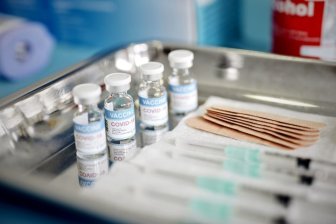
[ad_1]
Ontario is reporting 2,467 people with COVID in hospitals as the province continues to deal with the Omicron wave impacting hospitals and ICU.
The province also reported 9,706 new COVID cases on Monday. The provincial case total now stands at 888,297.
Over the last three days, there were 11,959 new infections on Sunday, 13,362 reported on Saturday, and 11,899 new cases on Tuesday.
However, due to recent testing eligibility changes the province warns the counts are an underestimate of the true spread of the virus in the community.
Of the 9,706 new cases recorded, the data showed 1,307 were unvaccinated people, 263 were partially vaccinated people, 7,789 were fully vaccinated people and for 347 people the vaccination status was unknown.
For the regional breakdown, 1,879 cases were recorded in Toronto, 1,310 in Peel Region, 1,033 in York Region, 680 in Durham, and 565 in Ottawa. All other local public health units reported fewer than 500 new cases in the provincial report.
Hospitalizations in Ontario
Ontario reported 2,467 people in hospital wards with COVID-19 (up by 48 from the previous day) with 438 patients in intensive care units (up by 26).
Last Monday, there were 1,232 hospitalizations with 248 in ICUs.
Although Omicron is considered less severe than Delta, the unprecedented surge in cases has driven hospitalizations and ICU admissions to soar as Ontario grapples to contain Omicron. Staffing shortages due to the new variant have impacted hospitals as the need for beds increases. Non-urgent surgeries have been ordered to pause.
In terms of vaccination status, for those in general hospital wards with COVID, 457 were unvaccinated, 115 were partially vaccinated and 1,353 were fully vaccinated. For patients in ICUs, 123 were unvaccinated while 18 were partially vaccinated and 137 were fully vaccinated. Due to the weekend the data is as of Saturday. This dataset will grow and improve over time, officials noted.
In population comparison, as the majority of Ontarians are vaccinated, those who are unvaccinated are still far more likely to land in hospital or ICU than the vaccinated, according to Ontario’s COVID-19 Science Advisory Table.
Deaths, vaccinations, recoveries, active cases, 7-day average, testing, test positivity
The death toll in the province has risen to 10,378 as 12 more virus-related deaths were added.
As of 8 p.m. on Sunday, there are more than 11.4 million people fully immunized with two doses, which is 88.4 per cent of the aged 12 and older population. First dose coverage stands at 91.1 per cent. Third dose immunization is at 36.9 per cent.
For young children aged five to 11, first dose coverage stands at 46.7 per cent with 3.5 per cent who are now fully vaccinated.
The province administered 93,741 doses in the last day. There are more than 4.7 million Ontarians who have received a booster shot.
Meanwhile, 737,396 Ontario residents were reported to have recovered from COVID-19, which is around 83 per cent of known cases. Resolved cases increased by 6,993 from the previous day.
Active cases in Ontario now stand at 140,523 — up from last week when it was at 130,307. At the peak of the second wave in January, active cases hit just above 30,000. In the third wave peak in April, active cases topped 43,000.
The government said 40,692 tests were processed in the previous 24 hours. There are 95,540 tests currently under investigation.
Test positivity hit 26.7 per cent meaning more than 1 in 4 tests are coming back positive for COVID. Last week, test positivity was at 31.9 per cent.
The seven-day average is at 11,885 as daily case counts due to Omicron continue to hover around unprecedented highs but are overall on a decline. This is down from 14,074 a week ago.
However, Ontario officials have recently changed testing eligibility for those seeking to get a PCR test to detect COVID-19 to only the most high-risk populations such as health care, long-term care, those who live and work in congregate settings, etc. meaning testing and cases are inaccurate due to restrictions.
Here is a breakdown of the total cases in Ontario by gender and age:
- 434,713 people are male — an increase of 4,125 cases.
- 450,013 people are female — an increase of 5,456 cases.
- 25,868 people are under the age of four — an increase of 230 cases.
- 54,734 people are 5 to 11 — an increase of 359 cases.
- 80,256 people are 12 to 19 — an increase of 694 cases.
- 342,994 people are 20 to 39 — an increase of 3,776 cases.
- 245,970 people are 40 to 59 — an increase of 2,913 cases.
- 105,569 people are 60 to 79 — an increase of 1,225 cases.
- 32,692 people are 80 and over — an increase of 512 cases.
- The province notes that not all cases have a reported age or gender.
© 2022 Global News, a division of Corus Entertainment Inc.
[ad_2]
Source link


